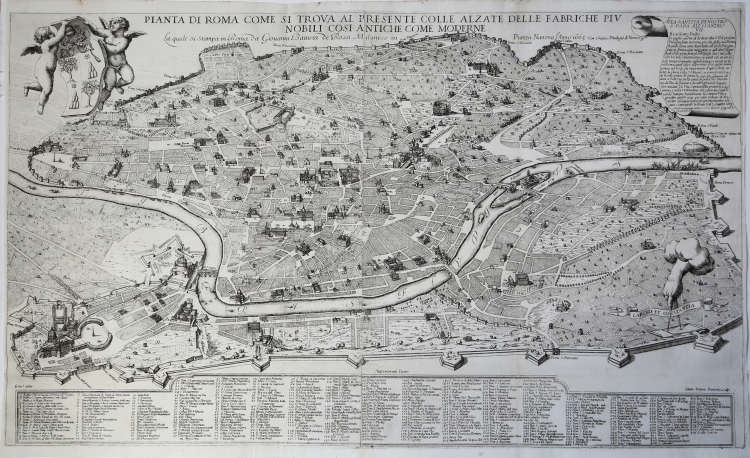



| Reference: | OS36 |
| Author | Lievin CRUYL |
| Year: | 1665 |
| Zone: | Rome |
| Printed: | Rome |
| Measures: | 825 x 495 mm |


| Reference: | OS36 |
| Author | Lievin CRUYL |
| Year: | 1665 |
| Zone: | Rome |
| Printed: | Rome |
| Measures: | 825 x 495 mm |
- THE VERY RARE EARLY EDITION -
Etching with engraving, 1665. A fine impression, with plate tone, of the first state of three, printed on 2 sheets of contemporary laid paper, small margins, perfectly reapired tears visible on verso, otherwise very good condition.
This map was published for the first time in 1665 by De Rossi; it is one of the rare images of the city depicting, at the same time, an iconographic and perspective system.
The views are the same that the Flemish artist engraved afterwards as a sort of personal catalogue.
This example has been printed by Giovanni Battista De Rossi in 1665. The plate was then published by Matteo Gregorio de Rossi in 1696 and finally reissued by Carlo Losi, in 1773.
It has been engraved by Giulio Testone on two copper plates.
The eternal city is portrayed towards the end of the reign of Alexander VII as Pope. He is renowned for improving and beautifying Rome: large areas were cleared to create straighter streets, broad piazzas, and the Collegio Romano. "The decorations of the church of Sta. Maria del Popolo, titular church of more than one of the Chigi cardinals, the Scala Regia, the Chair of St. Peter in the Vatican Basilica, and the great colonnade before that edifice bespeak alike the genius of Bernini and the munificence of his papal patron. He was also a patron of learning, modernized the Roman University, known as Sapienza, and enriched it with a magnificent library. He also made extensive additions to the Vatican Library. His tomb by Bernini is one of the most beautiful monuments in St. Peter's" (Peterson).
Beyond the walls of Rome, Alexander spent many years being antagonized by the young King Louis XIV of France, who had never forgiven him, as a young envoy, for so successfully defending the Vatican's interests at the Treaty of Westphalia in 1648 that had ended the Thirty Years War. Alexander assisted the Venetians in their long campaign against the Ottoman Empire and in return obtained the restoration of the Jesuits, exiled from Venice since 1606.
Cruyl was a Flemish priest, draughtsman and etcher, active also in Italy and France. In 1664 Cruyl arrived in Rome, where he lived until about 1670. "During this time he drew many views of the city (e.g. 18 sheets, Cleveland, OH, Mus. A.) and etched ten plates representing the Triumph of Caesar after Andrea Mantegna's series (Hollstein, nos 1–10). His etched views of Rome and its surroundings appeared in several contemporary publications. For instance, two series of 25 prints (Hollstein, nos 27–76) were first published in 1667 and were later included in Graevius's "Thesaurus antiquitatum Romanarum" and in F. Desseine's "Het oude en heden daagsche Rome" (Esther).
Bibliografia
Arrigoni-Bertarelli (1939): n. 142; Christie’s (1998): p. 50, n. 1043; Ehrle (1908): p. 23; Frutaz (1962): pp. 216-217, n. CLIV, Tav. 343; Hülsen (1915): XXIV, pp. 87-89, nn. 110-111; Jatta (1992): p. 166, n. 31s; Jatta (2012); Marigliani (2007): pp. 216-217, n. 124 e p. 249, n. 155; Roma Veduta (2000): p. 175, n. 31; Scaccia Scarafoni (1939): pp. 125-126, n. 241.
Lievin CRUYL (Ghendt 1640 - 1720)
|
Flemish priest, draughtsman and etcher, active also in Italy and France. While living in Wetteren (nr Ghent), he was involved in the completion of the Gothic St Michielskerk in Ghent. The construction of the western tower had been interrupted in 1566 because of religious unrest, and in 1652 steps were taken to complete it. After a Renaissance design was proposed in 1653, Cruyl submitted a drawing in Brabantine Late Gothic style (Ghent, Bib. Rijksuniv.) in 1662. His tower was to have been 134 m high, higher than the north tower of Antwerp Cathedral (1521). However, the project was never realized because of lack of funds. Although unoriginal and of an outdated style, the design had elegance and grandeur
|
Lievin CRUYL (Ghendt 1640 - 1720)
|
Flemish priest, draughtsman and etcher, active also in Italy and France. While living in Wetteren (nr Ghent), he was involved in the completion of the Gothic St Michielskerk in Ghent. The construction of the western tower had been interrupted in 1566 because of religious unrest, and in 1652 steps were taken to complete it. After a Renaissance design was proposed in 1653, Cruyl submitted a drawing in Brabantine Late Gothic style (Ghent, Bib. Rijksuniv.) in 1662. His tower was to have been 134 m high, higher than the north tower of Antwerp Cathedral (1521). However, the project was never realized because of lack of funds. Although unoriginal and of an outdated style, the design had elegance and grandeur
|